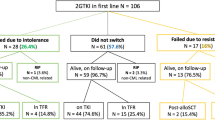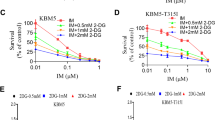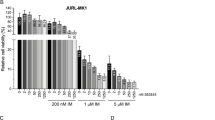Abstract
4-(4-Pyridinyl methylene) curcumin (C1206) is a new derivative of curcumin that is more active than curcumin in inhibition of heat shock protein 90 (Hsp90) and antitumor action. In this study we investigated the relationship between C1206-induced inhibition of Hsp90 and its anti-leukemic effects. The fluorescence quenching experiments showed that C1206 seemed to bind the middle dimerization domain of Hsp90. The interaction between C1206 and Hsp90 was driven mainly by electrostatic interaction. In in vitro enzyme activity assay, C1206 dose-dependently inhibited Hsp90 ATPase activity with an IC50 value of 4.17 μmol/L. In both imatinib-sensitive K562 chronic myeloid leukemia cells and imatinib-resistant K562/G01 chronic myeloid leukemia cells, C1206 (0.4–3.2 μmol/L) dose-dependently caused the degradation of Hsp90 client proteins and downstream proteins (AKT, MEK, ERK, C-RAF, P-AKT, P-MEK and P-ERK). Furthermore, C1206 (0.4–3.2 μmol/L) dose-dependently induced apoptosis of K562 and K562/G01 cells through triggering mitochondrial pathway. Consistent with this result, C1206 inhibited the proliferation of K562 and K562/G01 cells with IC50 values of 1.10 and 0.60 μmol/L, respectively. These results suggest that C1206 is a novel Hsp90 inhibitor and a promising therapeutic agent for chronic myeloid leukemia.
Similar content being viewed by others
Log in or create a free account to read this content
Gain free access to this article, as well as selected content from this journal and more on nature.com
or
References
Wegele H, Muller L, Buchner J . Hsp70 and Hsp90-a relay team for protein folding. Rev Physiol Biochem Pharmacol 2004; 151: 1–44.
Richter K, Hendershot LM, Freeman BC . The cellular world according to Hsp90. Nat Struct Mol Biol 2007; 14: 90–4.
Noguchi M, Yu D, Hirayama R, Ninomiya Y, Sekine E, Kubota N, et al. Inhibition of homologous recombination repair in irradiated tumor cells pretreated with Hsp90 inhibitor 17-allylamino-17- demethoxygeldanamycin. Biochem Biophys Res Commun 2006; 351: 658–63.
Soga S, Neckers LM, Schulte TW, Shiotsu Y, Akasaka K, Narumi H, et al. KF25706, a novel oxime derivative of radicicol, exhibits in vivo antitumor activity via selective depletion of Hsp90 binding signaling molecules. Cancer Res 1999; 59: 2931–8.
Harashima K, Akimoto T, Nonaka T, Tsuzuki K, Mitsuhashi N, Nakano T . Heat shock protein 90 (Hsp90)chaperone complex inhibitor, radicicol potentiated radiation-induced cell killing in a hormone-sensitive prostate cancer cell line through degradation of the androgen receptor. Int J Radiat Biol 2005; 81: 63–76.
Neckers L . Heat shock protein 90: the cancer chaperone. J Biosci 2007; 32: 517–30.
Wu LX, Xu JH, Huang XW, Zhang KZ, Wen CX, Chen YZ . Down-regulation of P210bcr/abl by curcumin involves disrupting the molecular chaperone functions of Hsp90. Acta Pharmacol Sin 2006; 27: 694–9.
Chen C, Lui Y, Chen YZ, Xu JH . C086, a novel analog of curcumin, induces growth inhibition and ownregulation of NFκB in colon cancer cells and xenograft tumors. Cancer Biol Ther 2011; 12: 797–807.
Wu LX, Yu J, Chen RJ, Liu Y, Lou LG, Wu Y, et al. Dual inhibition of Bcr-Abl and Hsp90 by C086 potently inhibits the proliferation of imatinib-resistant CML Cells. Clin Cancer Res 2015; 21: 833–43.
Chen JJ, Guo QJ, He XM, Yang SX, Chen C, Zhang LR . Study on a screening model for inhibitor of Hsp90 ATPase activity. J Xiamen Univ 2010; 49: 711–6.
Gao PZ, Wu H, Guo J, Xu YM . Study on the interaction between breviscapinum and bovine serum albumin by fluorescence spectrometry. Chin JMAP 2012; 29: 106–9.
Meng A, Wang Y, Brown SA, Van ZG, Zhou D . Ionizing radiation and busulfan inhibit murine bone marrow cell hematopoietic function via apoptosis-dependent and -independent mechanisms. Exp Hematol 2003; 31: 1348–56.
Zhang G, Keita B, Brochon JC, Oliveira PD, Nadjo L, Craescu CT, et al. Molecular interaction and energy transfer between human serum albumin and polyoxometalates. J Phys Chem B 2007; 111: 1809–14.
Chakraborty B, Basu S . Interaction of BSA with proflavin: A spectroscopic approach. J Lumin 2009; 129: 34–9.
Pastukhov AV, Levchenko LA, Sadkov AP . Spectroscopic study on binding of rutin to human serum albumin. Mol Struct 2006; 842: 60–6.
Yan CN, Tong JQ, Xiong D, Liu Y, Pan ZT . Studies on the binding reaction features between pefloxacin and bovine serum albumin by fluorescence spectrophtometry. Chin J Anal Chem 2006; 6: 796–800.
Ross PD, Subramanian S . Thermodynamics of protein association reactions: forces contributing to stability. Biochemistry 1981; 20: 3096–102.
Zhang X, Kou ZN, Shi YJ, Zhu JB . Investigation on effect of fluorescence enhancement of Danshensu-BSA system by synchronous fluorescence spectrometry. J Instrument Anal 2011; 30: 444–7.
Tretiakova I, Blaesius D, Maxia L, Wesselborg S, Schulze-Osthoff K, Cinatl J Jr, et al. Myrtucommulone from Myrtus communis induces apoptosis in cancer cells via the mitochondrial pathway involving caspase-9. Apoptosis 2008; 13: 119–31.
Tian Z, Shen J, Moseman AP, Yang QL, Yang JS, Xiao PG, et al. Dulxanthone A induces cell cycle arrest and apoptosis via up-regulation of p53 through mitochondrial pathway in HepG2 cells. Int J Cancer 2008; 122: 31–8.
Del BB, Valentini MA, Comporti M, Maellaro E . Cisplatin-induced apoptosis in melanoma cells: role of caspase-3 and caspase-7 in Apaf-1 proteolytic cleavage and in execution of the degradative phases. Ann N Y Acad Sci 2003; 1010: 200–4.
Troiano L, Ferraresi R, Lugli E, Nemes E, Roat E, Nasi M, et al. Multiparametric analysis of cells with different mitochondrial membrane potential during apoptosis by polychromatic flow cytometry. Nat Protoc 2007; 2: 2719–27.
Falsone SF, Gesslbauer B, Tirk F, Piccinini AM, Kungl AJ . A proteomic snapshot of the human heat shock protein 90 interactome. FEBS Lett 2005; 579: 6350–4.
Kamal A, Boehm MF, Burrows FJ . Therapeutic and diagnostic implications of Hsp90 activation. Trends Mol Med 2004; 10: 283–90.
Zhao R, Davey M, Hsu YC, Kaplanek P, Tong A, Parsons AB, et al. Navigating the chaperone network: an integrative map of physical and genetic interactions mediated by the Hsp90 chaperone. Cell 2005; 120: 715–27.
Neckers L . Development of small molecule Hsp90 inhibitors: utilizing both forward and reverse chemical genomics for drug identification. Curr Med Chem 2003; 10: 733–9.
Whitesell L, Mimnaugh EG, De Costa B, Myers CE, Neckers LM . Inhibition of heat shock protein Hsp90-pp60v-src heteroprotein complex formation by benzoquinone ansamycins: essential role for stress proteins in oncogenic transformation. Proc Natl Acad Sci U S A 1994; 91: 8324–8.
Supko JG, Hickman RL, Grever MR, Malspeis L . Preclinical pharmacologic evaluation of geldanamycin as an antitumor agent. Cancer Chemother Pharmacol 1995; 36: 305–15.
Rivera-Espinoza Y, Muriel P . Pharmacological actions of curcumin in liver diseases or damage. Liver Int 2009; 29: 1457–66.
Wei JS, Yu ZW, Chiang YC, Yang Y, Chai TY, Folt W, et al. Curcumin prevents high fat diet induced insulin resistance and obesity via attenuating lipogenesis in liver and inflammatory pathway in adipocytes. PLoS One 2012; 7: e28784.
Wu LX, Xu JH, Wu GH, Chen YZ . Inhibitory effect of curcumin on proliferation of K562 cells involves down-regulation of P210bcr-abl-initiated Ras signal transduction pathway. Acta Pharmacol Sin 2003; 24: 1155–60.
Qi J, Peng H, Gu ZL, Liang ZQ, Yang CZ . Establishment of an imatinib resistant cell line K562/G01 and its characterization. Zhonghua Xue Ye Xue Za Zhi 2004; 25: 337–41.
Hossain DM, Bhattacharyya S, Das T, Sa G . Curcumin: the multitargeted therapy for cancer regression. Front Biosci (Schol Ed) 2012; 4: 335–55.
Pastukhov AV, Levchenko LA, Sadkov AP . Spectroscopic study on binding of rutin to human serum albumin. Mol Struct 2006; 842: 60–6.
Felts SJ, Karnitz LM, Toft DO . Functioning of the Hsp90 machine in chaperoning checkpoint kinase I (Chk1) and the progesterone receptor (PR). Cell Stress Chaperones 2007; 12: 353–63.
Riggs D, Cox M, Cheung-Flynn J, Prapapanich V, Carrigan P, Smith D . Functional specificity of co-chaperone interactions with Hsp90 client proteins. Crit Rev Biochem Mol Biol 2004; 39: 279–95.
Pearl LH, Prodromou C, Workman P . The Hsp90 molecular chaperone: an open and shut case for treatment. Biochem J 2008; 410: 439–53.
Whitesell L, Lindquist SL . HSP90 and the chaperoning of cancer. Nat Rev Cancer 2005; 5: 761–72.
Sato S, Fujita N, Tsuruo T . Modulation of Akt kinase activity by binding to Hsp90. Proc Natl Acad Sci U S A 2000; 97: 10832–7.
Kang BH, Plescia J, Dohi T, Rosa J, Doxsey SJ, Altieri DC . Regulation of tumor cell mitochondrial homeostasis by an organelle-specific Hsp90 chaperone network. Cell 2007; 131: 257–70.
Acknowledgements
This work was funded by Fujian Provincial Health and Family Planning Commission of China (2015-1-72), the Natural Science Foundation of Fujian Province of China (2017J01821), the National Science and Technology Foundation of China for Key Projects of “Major New Drugs Innovation and Development” (2012ZX09103-101-028) and the Joint Funds for the Innovation of Science and Technology, Fujian Province (2016Y9059).
Author information
Authors and Affiliations
Corresponding author
Rights and permissions
About this article
Cite this article
Fan, Yj., Zhou, Yx., Zhang, Lr. et al. C1206, a novel curcumin derivative, potently inhibits Hsp90 and human chronic myeloid leukemia cells in vitro. Acta Pharmacol Sin 39, 649–658 (2018). https://doi.org/10.1038/aps.2017.160
Received:
Accepted:
Published:
Issue date:
DOI: https://doi.org/10.1038/aps.2017.160
Keywords
This article is cited by
-
Curcumin derivative C210 induces Epstein–Barr virus lytic cycle and inhibits virion production by disrupting Hsp90 function
Scientific Reports (2024)
-
C0818, a novel curcumin derivative, induces ROS-dependent cytotoxicity in human hepatocellular carcinoma cells in vitro via disruption of Hsp90 function
Acta Pharmacologica Sinica (2022)
-
Curcumin derivative C212 inhibits Hsp90 and eliminates both growing and quiescent leukemia cells in deep dormancy
Cell Communication and Signaling (2020)
-
Effectiveness evaluation of natural fractures in Xujiahe Formation of Yuanba area, Sichuan basin, China
Arabian Journal of Geosciences (2019)



